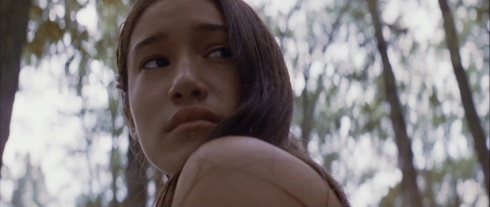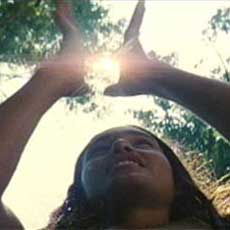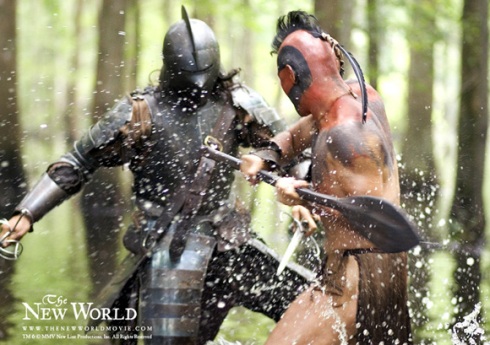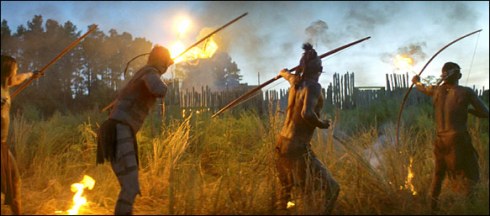You are currently browsing the tag archive for the ‘Pocahontas’ tag.
Director: Terrence Malick (2005)
Pocahontas (Q’orianka Kilcher); John Smith (Colin Farrell)

Terrence Malick. The New World is a true film – a pure film. One that is so inherently connected to the idea of film, the images, the meditative landscapes and cinematic sweeps, the profoundly deep emotional impact, that it is almost a thing uniquely apart. It is an artistic creation that surpasses the notion of best film of the year or awards shows because it transcends the concept – it is a creation that is perfectly linked to the nature of film and its visual and emotional aspects of the medium. So it is not easy to talk about. That said, however, there are a number of wonderful subtexts to this film. Malick is always the meditative filmmaker, combining action and emotion and movement with periods of reflection and solitude and quiet. In a sense, his films pulse – and they rely on this pulsation between ideas and time to formulate and absorb them to fully engage the viewer.
Almost the entire film, in almost every aspect of it, functions within a duality of ideas. There is the philosophical yin-yang of almost every scene and sentence that he presents – and it causes a unique and powerful sensation. This is one of the most beautiful films made in years – and it is one of the saddest and most powerfully draining. It is a love story that feels simultaneously like discovery and complete loss. It is an observation on the world as something man pursues, explores, discovers and conquers but, at the same time, one that he tarnishes, corrupts, destroys and ultimately loses.

Pocahontas is a symbol of this. She is the native, but becomes the immigrant – the first American coming to a strange land and language and needing to assimilate to its culture. The Europeans come to land as the visitors and explorers, but they possess the land upon arrival, immediately oozing ownership of it almost as soon as the anchor is thrown.

The plotline is a love story, told in flowering terms with devotion and discovery injected into every meeting, every moment of their courtship. It exists in this utopian situation, this place full of only freedom and new wonders. It is an escape from the world that John Smith knows and he says that it exists like a dream. Malick plays with the imagery, showing us scenes of the woods reflected in water, perfectly still and then, in a moment, with ripples running through the image. It is a mirror of the world, the place that Smith talks about in his journey, the opportunity to start new, to have no man answer in deference to another, but the world of rules and order shimmers at the edges. It cannot be held away forever and the sense of it ripples through this dream utopia. But the image has more to it – it leaves the ambiguity about which is the real world, which world is the truth, the one we live in or the one we see. And it feels always just out of reach. So that even here, at the films most lush and lovely, there is this haunting reflection, the yang to its yin, the perfectly equal and reflecting opposite to the idea.


Pocahontas learns the language, the ideals and constructs of the culture of Europe. Yet in almost everything that she says is this sense of loss, this duality of intent. She says “I give myself to you, you are a god.” It is a line of love and giving, but it is the loss of herself that you feel at the same time, because she is discovering this new wonder (love) but it comes with the ideas of possession and god and ownership and all that makes her utopian world vanish.
There is a strong, meaningful contrast between the natives and the English. Both are presented fairly. The Indians, despite their setting, are not peaceful, idealistic characters; they also have their violence, their fear, their aggressions. On the other hand, the white man rejects nature and he suffers for it. He becomes walled in by their little fort, unprepared for the winter, with nothing to eat, relying on things of zero value to save them. At the same time, the natives prosper by accepting instead of resisting the earth. Late in the film, in the scenes in England, there is a nice contrast with this. We see what becomes of the wild, utopian freedom of the American woods as order and symmetry takes over the gardens of England; the paving over and clipping of all the trees into pointless shapes. The film shows the duality affixed to this – the absurdity of ‘progress’ and how it squeezes out anything natural or meaningful; the inevitabilities of progress and loss.

All of these themes are reflections of the duality in the nature of the observations within the film. The film also presents the contrasting philosophies at the heart of the two tribes; the internal ‘taking’ to the external ‘giving’. Pocahontas is always moving her hands from her chest outward, to the world and the sky, giving outward – the Indians seemed to have this exposure of their soul: it is external, of the earth and the sky. As its opposite, the Europeans were always constructing walls around their possessions. The armor in the beginning was a great metaphor for this – the naked Indians with only stained skin tapping and poking the armor, and the Europeans all wrapped up, protected and cold, steely and completely useless in their gear, all their senses cut off and, like a big clunky machine, unable to defend themselves or see their attackers. It builds in theme throughout the first part of the film, so that when John Smith comes back to the camp in winter, as starvation and desperation has struck the English, you are asking yourself what are they protecting? And inside, when the gates open, it is just emptiness and disease – a rotting. The skeleton of an unfinished church. It is a lovely metaphor: the housing of our souls, made interior and contained.
But Malick goes much further with it. When Pocahontas goes to London, and you first see the cathedral, it is stunning, unbelievable. You see it in a way you’ve never seen it before. All of the wonder and amazement of man’s ability and creation – you can feel it. See it. Then the point is driven home: the cathedral – while a true testament to the amazing achievements of man and the beauty of his creations – is dark and empty inside, a fancy wall built to protect nothing, closing off the sky and worshiping only ourselves and our ability to make. It is why the Indian runs out – to escape this captivity. And we are left with the sense of a world lost, even while it has only just been born.

